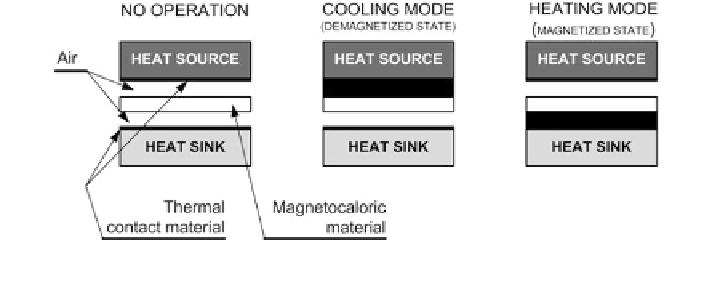Environmental Engineering Reference
In-Depth Information
Fig. 6.9 Example of a thermal switch based on a mechanical contact
mechanical thermal switch serves for the thermal contact between the heat source
and the heat sink. The mechanisms behind these kinds of switches are based on
thermal actuation (the temperature-dependent elongation of materials), as well as
other types of actuation (electric, magnetic, chemical, etc.). Figure
6.9
shows an
example of a thermal switch based on a mechanical contact.
According to Fig.
6.9
there is a gap between the heat source and the heat sink. In
our particular case we will consider that air is used to
ll this gap. In the cooling
mode, when the magnetocaloric material is in the demagnetized state, the thermal
contact material (thermal switch) is active, which means that it is elongated and in
such a way that it is in contact with the heat source. The heat is transferred through
the thermal switch by thermal diffusion (conduction). In the heating mode, the
lower thermal switch is active and the upper thermal switch is inactive. Now the
heat
ux can be transferred to the heat sink.
The thermally rectifying materials, which are based on thermally activated
elongation, must exhibit high thermal conductivity. Most of these mechanisms can
be referred to as passive and thermally actuated. This group of materials includes
elastomers (solid, liquid), bimetals, shape-memory alloys, etc.
Shape-memory metallic alloys exhibit thermomechanical actuation. One of the
most representative alloys is the nickel
fl
-
titanium alloy; however, there are a number
·
of other potential materials, e.g. Co
-
Ni
-
Al, Co
Ni
-
Ga, Fe
-
Mn
-
Si, Cu
-
Al
-
Ni,
Cu
Pt. In the group of non-metallic materials we should not neglect the
shape-memory polymers [
57
-
Zn and Fe
-
62
], which can be activated by many different
mechanisms, i.e. thermal, electrical, radiative (light), magnetic or chemical [
62
].
The selection of shape-memory materials generally depends on the mode of actu-
ation, the operating temperature and the desired behaviour.
Other types of materials can be referred to as bimetals. This kind of material is
made by bonding different metals in a bimetallic strip, e.g. steel and copper or steel
and brass, whereas each metal possesses a different coef
-
cient of thermal expan-
sion. The temperature gradient will lead to the mechanical displacement of such
material.
The major drawback of all contact thermal switch mechanisms, besides the
thermal contact resistance between the thermal switch and the magnetocaloric

Search WWH ::

Custom Search